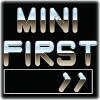
The bombed remains of St James Church which stood at the top of Southgate Street, roughly where Marks & Spencer stands today. The building was eventually demolished in 1957. The city was bombed in April 1942 as part of the so-called “Baedeker raids”, in which targets were chosen for their cultural and historical, rather than their strategic or military, value. Bath was largely untouched during the Blitz, the German night bombing offensive against Britain's cities, though nearby Bristol was bombed severely throughout that period. Bath was subject to numerous air raid warnings as raiders flew overhead on their way to Bristol, but no bombs were dropped on Bath at this point. Over the weekend of 25–27 April 1942, Bath suffered three raids, from 80 Luftwaffe aircraft which took off from Nazi occupied northern France. As the city sirens wailed, few citizens took cover, even when the first pathfinder flares fell, the people of Bath still believed the attack was destined for nearby Bristol. During the previous four months Bristol had been hit almost every night, so the people of Bath did not expect the bombs to fall on them. The first raid struck just before 11 pm on the Saturday night and lasted until 1 am. The German aircraft then returned to France, refuelled, rearmed and returned at 4.35 am. Bath was still on fire from the first raid, making it easier for the German bombers to pick out their targets. The third raid, which only lasted two hours but caused extensive damage, commenced in the early hours of Monday morning. The bombers flew low to drop their high explosives and incendiaries and then returned to rake the streets with machine-gun fire. 417 people were killed, another 1,000 injured. Over 19,000 buildings were affected including 218 of architectural or historic interest.



![[EAW000757] The Abbey Church of St Peter and St Paul looking towards St James's Bridge, Bath, 1946](http://britainfromabove.org.uk/sites/all/libraries/aerofilms-images/public/100x100/EAW/000/EAW000757.jpg)
![[EAW000756] The Church of St John the Evangelist, Abbey Church of St Peter and St Paul and surrounding city, Bath, 1946](http://britainfromabove.org.uk/sites/all/libraries/aerofilms-images/public/100x100/EAW/000/EAW000756.jpg)
![[EAW000755] The Church of St John the Evangelist, Abbey Church of St Peter and St Paul and surrounding city, Bath, 1946](http://britainfromabove.org.uk/sites/all/libraries/aerofilms-images/public/100x100/EAW/000/EAW000755.jpg)
![[EAW023884] North Parade Bridge and the city centre, Bath, 1949. This image has been produced from a print.](http://britainfromabove.org.uk/sites/all/libraries/aerofilms-images/public/100x100/EAW/023/EAW023884.jpg)
![[EAW023882] The Abbey Church of St Peter and St Paul and the city centre, Bath, from the south-east, 1949. This image has been produced from a print.](http://britainfromabove.org.uk/sites/all/libraries/aerofilms-images/public/100x100/EAW/023/EAW023882.jpg)
![[EAW000754] The city, Bath, from the east, 1946](http://britainfromabove.org.uk/sites/all/libraries/aerofilms-images/public/100x100/EAW/000/EAW000754.jpg)
![[EAW000748] The Church of St James, Abbey Church of St Peter and St Paul and the surrounding city, Bath, 1946](http://britainfromabove.org.uk/sites/all/libraries/aerofilms-images/public/100x100/EAW/000/EAW000748.jpg)
![[EAW000746] The Abbey Church of St Peter and St Paul and environs, Bath, 1946](http://britainfromabove.org.uk/sites/all/libraries/aerofilms-images/public/100x100/EAW/000/EAW000746.jpg)
![[EPW001942] The Abbey Church of St Peter and St Paul and town centre, Bath, 1920](http://britainfromabove.org.uk/sites/all/libraries/aerofilms-images/public/100x100/EPW/001/EPW001942.jpg)
![[EAW000758] North Parade looking towards the railway station, Bath, 1946](http://britainfromabove.org.uk/sites/all/libraries/aerofilms-images/public/100x100/EAW/000/EAW000758.jpg)
![[EPW001957] General view of the town centre, Bath, from the east, 1920](http://britainfromabove.org.uk/sites/all/libraries/aerofilms-images/public/100x100/EPW/001/EPW001957.jpg)
![[EPW001945] The Abbey Church of St Peter and St Paul, Bath, 1920](http://britainfromabove.org.uk/sites/all/libraries/aerofilms-images/public/100x100/EPW/001/EPW001945.jpg)
![[EPW033153] The Abbey Church of St Peter and St Paul and the city, Bath, 1930](http://britainfromabove.org.uk/sites/all/libraries/aerofilms-images/public/100x100/EPW/033/EPW033153.jpg)
![[EAW000759] The Abbey Church of St Peter and St Paul and the surrounding city, Bath, from the north-east, 1946](http://britainfromabove.org.uk/sites/all/libraries/aerofilms-images/public/100x100/EAW/000/EAW000759.jpg)
![[EAW023885] Parade Gardens and the city centre, Bath, 1949. This image has been produced from a print.](http://britainfromabove.org.uk/sites/all/libraries/aerofilms-images/public/100x100/EAW/023/EAW023885.jpg)
![[EPW001161] View over Bath city centre and the Abbey, Bath, 1920](http://britainfromabove.org.uk/sites/all/libraries/aerofilms-images/public/100x100/EPW/001/EPW001161.jpg)
![[EPW001953] General view of the town centre, Bath, 1920](http://britainfromabove.org.uk/sites/all/libraries/aerofilms-images/public/100x100/EPW/001/EPW001953.jpg)
![[EAW000760] The Abbey Church of St Peter and St Paul and the surrounding city, Bath, 1946](http://britainfromabove.org.uk/sites/all/libraries/aerofilms-images/public/100x100/EAW/000/EAW000760.jpg)
![[EAW000747] The area around the Church of St James and New Orchard Street, Bath, 1946](http://britainfromabove.org.uk/sites/all/libraries/aerofilms-images/public/100x100/EAW/000/EAW000747.jpg)
![[EAW000749] The area between York Street and Southgate (Churchill) Bridge, Bath, 1946](http://britainfromabove.org.uk/sites/all/libraries/aerofilms-images/public/100x100/EAW/000/EAW000749.jpg)
![[EPW001950] The Weir and Parade Gardens, Bath, 1920](http://britainfromabove.org.uk/sites/all/libraries/aerofilms-images/public/100x100/EPW/001/EPW001950.jpg)
![[EPW053141] The Abbey Church of St Peter and St Paul, the Roman Baths and the city centre, Bath, 1937](http://britainfromabove.org.uk/sites/all/libraries/aerofilms-images/public/100x100/EPW/053/EPW053141.jpg)
![[EPW048403] Bath and County Recreation Ground, the Cricket Ground and environs, Bath, 1935](http://britainfromabove.org.uk/sites/all/libraries/aerofilms-images/public/100x100/EPW/048/EPW048403.jpg)
![[EAW026450] The city centre, Bath, from the east, 1949](http://britainfromabove.org.uk/sites/all/libraries/aerofilms-images/public/100x100/EAW/026/EAW026450.jpg)
![[EAW000761] The city, Bath, 1946](http://britainfromabove.org.uk/sites/all/libraries/aerofilms-images/public/100x100/EAW/000/EAW000761.jpg)
![[EAW049898] Bath, the second day of the Somerset-Kent county cricket match, 1953](http://britainfromabove.org.uk/sites/all/libraries/aerofilms-images/public/100x100/EAW/049/EAW049898.jpg)
